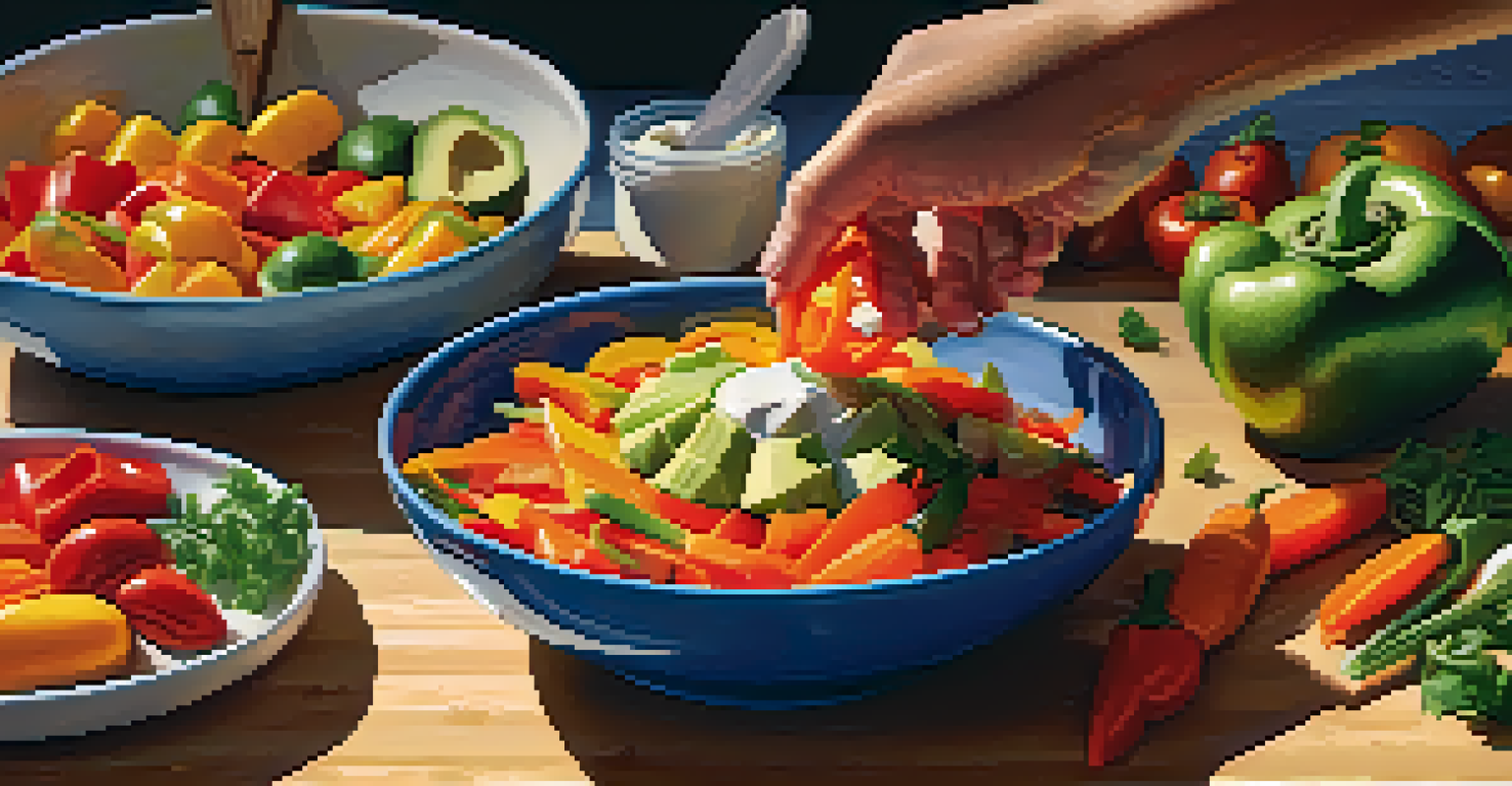How Raw Foods Promote Mindfulness in Eating Practices

Understanding Raw Foods and Mindfulness
Raw foods consist of unprocessed fruits, vegetables, nuts, and seeds, often enjoyed in their natural state. This eating approach encourages a focus on the present moment, as it emphasizes fresh and vibrant ingredients. When you choose to eat raw, each bite can become a sensory experience, inviting you to notice flavors, textures, and colors that might otherwise go unnoticed.
Eating is a necessity, but cooking is an art.
Mindfulness, at its core, is about being fully engaged in the current moment. By adopting a raw food lifestyle, you can cultivate this awareness during meals. The simplicity of raw foods allows you to pay attention to what you're consuming, fostering a deeper connection to your food and its origins.
As you explore raw foods, you may find that your eating habits shift away from distractions, such as screens or multitasking. Instead, meals become a dedicated time for reflection and enjoyment, helping you appreciate both the food and the act of eating itself.
The Connection Between Fresh Ingredients and Awareness
When you eat raw foods, you are often choosing ingredients that are fresh and vibrant. This freshness not only enhances flavor but also encourages a heightened awareness of what you’re consuming. The colors and textures of raw fruits and vegetables can stimulate your senses, inviting you to explore their unique qualities.

Think about biting into a crisp apple or savoring the juiciness of a ripe tomato. These sensory experiences can ground you in the present, making each meal a mindful occasion. The act of preparing raw foods, such as chopping vegetables or arranging a colorful salad, can also serve as a meditative practice.
Mindfulness Through Raw Eating
Adopting a raw food lifestyle enhances mindfulness by encouraging a deeper connection to food and the present moment.
By prioritizing fresh ingredients, you’re not just nourishing your body; you’re also fostering a mind-body connection that enhances your overall eating experience. This simple shift can lead to greater satisfaction and a deeper appreciation for the nourishment you receive.
Mindful Eating: Slowing Down with Raw Foods
One of the key principles of mindfulness is slowing down, particularly during meals. Raw foods encourage this practice, as they often require more time for preparation and consumption. When you take the time to prepare raw dishes, you are prompted to engage with your food on a deeper level, leading to a more thoughtful eating experience.
Mindfulness is a way of befriending ourselves and our experience.
As you eat, try to savor each bite, chewing slowly and paying attention to the flavors that unfold. This deliberate pace allows your body to recognize fullness and satisfaction, reducing the chances of overeating. By focusing on the textures and flavors of raw foods, you can truly appreciate the meal in front of you.
Incorporating this mindful approach can transform your relationship with food. Rather than viewing meals as a necessity, you'll start to see them as an opportunity to connect with your body and mind, enhancing your overall well-being.
Embracing Seasonal Eating with Raw Foods
Raw foods often align with seasonal eating, which can deepen your mindfulness. By choosing fruits and vegetables that are in season, you are not only supporting local agriculture but also tuning into nature's rhythms. This connection to the seasons encourages you to eat what’s freshest, which can be more flavorful and nutrient-rich.
Seasonal eating can also enhance your appreciation for food since you’re likely to experience a variety of flavors throughout the year. For example, enjoying juicy summer peaches or crunchy fall apples can create a sense of anticipation and joy in your meals. This awareness fosters a greater connection to the food you consume.
Embrace Seasonal Ingredients
Choosing seasonal raw foods not only supports local agriculture but also enriches your meals with freshness and variety.
As you embrace seasonal raw foods, you may find that your meals become more vibrant and diverse. This shift not only enhances your mindfulness but also enriches your overall eating experience, encouraging you to appreciate the bounty of each season.
The Role of Texture in Mindful Eating
The texture of raw foods plays a crucial role in fostering mindfulness. From the crispness of raw carrots to the creaminess of avocado, these varied textures can create a multi-sensory eating experience. Paying attention to how each food feels in your mouth can heighten your awareness and enjoyment during meals.
When you focus on texture, you're engaging more of your senses, which helps you slow down and appreciate each bite. This practice not only enhances your enjoyment but also helps you become more attuned to your body's signals of hunger and fullness. You may find that you’re more satisfied with smaller portions when you savor the experience.
Incorporating a variety of textures into your raw meals can make eating more playful and enjoyable. This diversity can keep you engaged and curious about your food, turning each meal into an opportunity for mindfulness.
Creating a Mindful Eating Environment
The environment in which you eat can significantly impact your mindfulness practices. Creating a calm and inviting space for your raw meals can help you focus on the experience of eating. Consider setting the table with beautiful plates, lighting candles, or playing soft music to enhance your atmosphere.
When you make an effort to create a mindful eating environment, it signals to your brain that it’s time to slow down and enjoy your meal. Remove distractions like screens or phones, allowing yourself to be fully present. This intentionality can transform your meals from a rushed task into a cherished ritual.
Create a Mindful Eating Space
Designing a calm and inviting environment for meals promotes mindfulness and transforms eating into a cherished ritual.
By cultivating a nurturing environment, you can enhance your connection to the food and promote a more mindful eating experience. Each meal becomes an opportunity to nourish not just your body, but your mind and spirit as well.
Building a Community Around Raw Foods
Sharing meals with others can enhance the mindfulness of your eating practices. Building a community around raw foods allows you to engage in meaningful conversations and share experiences related to health and nourishment. Cooking and enjoying raw meals together can create a sense of connection that enriches the entire experience.
Consider hosting a potluck featuring raw dishes or joining a local food group focused on raw eating. These gatherings not only provide an opportunity to try new recipes but also promote discussions about the benefits of mindful eating. This collaborative approach can deepen your understanding and appreciation of raw foods.

As you engage with others in the raw food community, you'll likely find inspiration and encouragement to continue your mindfulness journey. Together, you can explore the many ways raw foods can enhance your well-being and foster a more mindful approach to eating.